
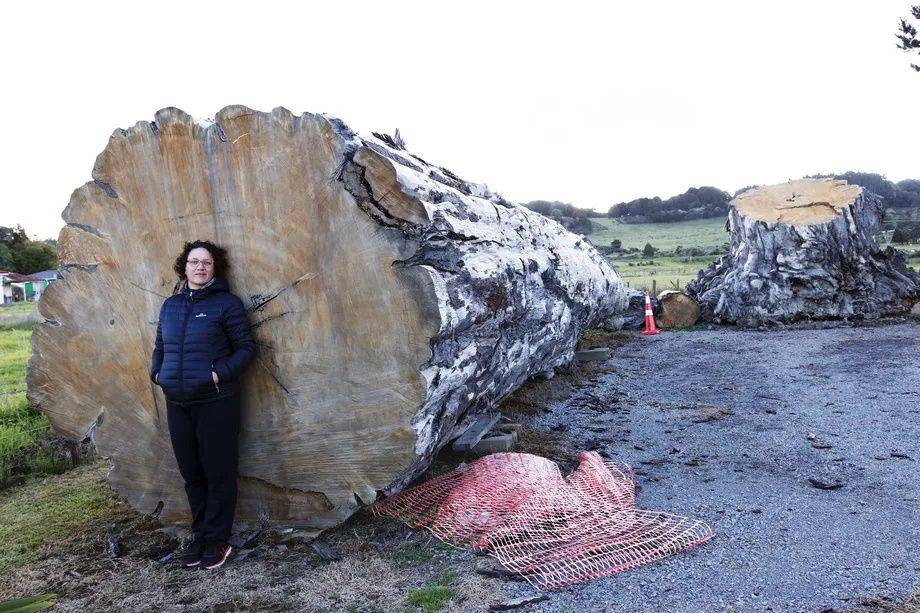
What a 1,600-year-old New Zealand tree can tell us about climate change
Buried in mud for millennia, some of the hulking kauri trees in rural Northland are portals to the past, present, and future of Earth’s climate.
/cdn.vox-cdn.com/uploads/chorus_image/image/69118228/Donna_with_Ngawha_kauri_15.0.jpg)
In February 2019, Mark Magee was scraping the bucket of his 45-ton excavator through a hillside when it hit something 30 feet down that wouldn’t budge.
It was high summer in the Southern Hemisphere, and Magee, a construction foreman, was clearing a platform for a new geothermal power plant near Ngāwhā, a tiny community in New Zealand’s Northland region, the long peninsula that stretches from the city of Auckland to the country’s northern tip.
He called in additional digger drivers to help. Gradually, as the machines peeled away the mudstone encasing the obstinate object, they realized it was a tree — and not an ordinary tree. More and more of it appeared, a seemingly endless log. When it lay uncovered, complete with a medusa-like rootball, it measured 65 feet long and 8 feet across, and weighed 65 tons.
It was a kauri tree, a copper-skinned conifer endemic to New Zealand. The indigenous Māori hold the species sacred and use its honey-colored softwood for traditional carvings and ocean-going canoes. Although this kauri tree had clearly been buried for thousands of years, Magee was astonished to see leaves and cones stuck to its underside that were still green.
The power company, Top Energy, called in a local sawmiller named Nelson Parker to examine Magee’s find. Parker, a champion woodchopper with powerful shoulders and a missing finger, had been digging up, processing, and selling kauri logs like this one since the early 1990s. As soon as his chainsaw bit into the bark, he knew from the color of the sawdust (dark yellow) and from the smell (subtle, resiny) that this tree was very old, and worth a lot of money.
Parker also knew that swamp kauri, as the buried trees are known, are worth a lot to science. One this large would be of special interest to a group of scientists who study the information that the ancient trees have coded into their rings. After removing the roots, he cut a four-inch-thick slice from the base of the trunk and sent it to them for analysis.
What he couldn’t know then was that this particular tree held the key to understanding an ancient global catastrophe — and how it may have shaped our collective past.
A brief history of the swamp kauri boom
The kauri tree, or Agathis australis, is one of the largest and longest-lived tree species in the world. An individual kauri can live for more than two millennia, reaching 200 feet tall and more than 16 feet in diameter. Today, the living trees grow only in remnant pockets in northern New Zealand, where the national Department of Conservation lists them as threatened, due to a century of heavy logging, forest clearing for agriculture, and, more recently, the onslaught of a deadly fungus-like pathogen.
Yet for tens of thousands of years, kauri forests dominated a vast swath of the upper North Island. As the trees grew, they recorded information in their annual rings about the climate and makeup of the atmosphere. When they fell, some of the heaviest plunged deep into nearby peat bogs, where they stayed mostly unchanged for millennia.
Itinerant 19th-century gumdiggers, who sought the swamp kauri’s preserved golden resin for use in varnish and jewelry, were the first to exploit the trees for profit, digging up fields and wetlands in search of buried gum. In 1985, after environmentalist protests, the New Zealand government banned loggers from cutting live kauri on public land, and Parker and other Northland timber merchants turned their attention to swamp kauri. They clawed the trees from the earth with excavators and sold the exotic wood to furniture makers in New Zealand, the United States, and several European and Asian countries.
The industry grew slowly until around 2010. Then, it exploded, thanks to demand from a booming China, where customers are often willing to pay more for materials with antiquity. Fetching up to $200 per cubic foot, swamp kauri became one of the most valuable timbers in the world. Chinese agents roamed rural Northland, New Zealand’s poorest region, offering farmers cash in exchange for the right to prospect on their land.
The lure of a fast buck also attracted a host of dubious kauri extractors. Among them were the aptly-named “Swamp Cowboys,” who drained endangered wetlands — only 8 percent of Northland’s wetlands are still intact — to reach their quarry. In the years that followed, conservation groups successfully fought to restrain the swamp kauri industry and hold the national Ministry for Primary Industries and regional council accountable. Finally, in 2018, New Zealand’s Supreme Court issued a unanimous decision limiting swamp kauri exports. By then, the shadiest companies had gone bankrupt, and swamp kauri exports dropped from more than 200,000 cubic feet in 2013 to around 10,000 cubic feet in 2019.
The end of the swamp kauri boom was a big victory for wetland advocates — and a big relief for the scientists who study the ancient trees. The slowdown has made it easier for them to take samples from every piece of unearthed swamp kauri before it disappears into the mill and heads out of the country. Every single tree, they know, has a story to tell.
Long-lived, well-preserved kauri are something of a “high-resolution time-capsule”
In a windswept paddock on Northland’s remote Karikari Peninsula, on a cool October day in 2019, I watch Andrew Lorrey use a chainsaw to cut a four-inch slab called a “biscuit” off the end of a huge kauri trunk. Around him, beached on the surface like stranded whales, were dozens more unearthed logs, their forms twisted and gum-encrusted, the tortured roots of their massive stumps reaching for a squally sky.
Lorrey, a stocky, bearded American originally from New England, is a climate scientist at New Zealand’s National Institute of Water and Atmospheric Research (NIWA). He came to the country in 2002 to study swamp kauri for his PhD. During the “gold rush” years, he felt a lot of pressure to “scurry around” collecting samples, knowing most of the wood was slipping through his fingers. But over time, he and a handful of other scientists forged relationships with the main timber extractors. “I want to look back and say I did what I could to get this precious natural archive preserved for science,” he tells me.
:no_upscale()/cdn.vox-cdn.com/uploads/chorus_asset/file/22432600/biscuit.jpg)
Swamp kauri fall into two age clusters: “young” trees that died anywhere between a few thousand and around 13,000 years ago, and “ancient” ones that were alive more than 25,000 years ago. No one has yet found a kauri from the roughly 12,000-year span in between. That was the height of the last glacial period, when temperatures were cooler and sea levels more than 300 feet lower. Scientists speculate that the kauri’s range may have shrunk during that time because of the cold, or that the forests moved to lower elevations on the continental shelf when sea levels fell, and were later submerged as the climate warmed and seas rose again. Or perhaps the trees from that time are simply still out there, waiting to be discovered.
The landowner here on the Karikari Peninsula, a taciturn, pipe-smoking farmer named Chris Hensley, found this batch of buried logs when he was converting an old pine forestry plantation to pasture. For Hensley, the kauri are a nuisance. “They bugger up the farm equipment,” Lorrey says. But for Lorrey, they’re treasure. After learning about them, he quickly organized an expedition, driving more than four hours from Auckland to examine them. Hensley had used his digger to lay the huge haul — 104 individual trees — on the ground like matchsticks. “When I got there, I said, ‘I’ve got gold,’” Lorrey remembers.
Now, Lorrey moves from log to log, slicing biscuits from each one, making detailed notes about their measurements and where they were found, then brushing the cut faces with a white glue-based paint to protect the wood from the elements.
While Lorrey works, Hensley arrives to watch. A tiny white fluffy dog jumps from his truck and runs frenetically among the dark logs. Knowing the age of the timber will help him sell it later, Hensley says. “This way I get them dated for free.”
There are other ancient trees in the world, but none as old, as long-lived, or as numerous as the kauri. Because migrating ice sheets demolished everything in their path, few trees survived the glacial periods in the Northern Hemisphere, and scientists have found only a handful — including one 23,000-year-old cypress buried in a volcanic mudflow near Mount Fuji in Japan. Northland, however, remained ice-free. “The kauri are globally unique,” Lorrey says. “There’s no other wood resource like it for this part of Earth’s history, full stop.”
Other natural climate archives, such as ice cores, lake sediments, and stalactites and stalagmites, also allow scientists to peer into the past. But trees are the “gold standard,” Lorrey says, because they directly sample the atmosphere and make a new record of it and other aspects of the environment in each annual growth ring of wood they lay down. Unlike ice cores and lake sediment, tree rings don’t compress over time. Multiple trees growing at the same time can be cross-referenced, too, smoothing out any local or individual variation that might interfere with broad conclusions about the climate. (Imagine a single tree growing poorly for a few seasons because its roots were waterlogged or it was shaded by others.) Long-lived, well-preserved kauri are therefore a kind of “high-resolution time-capsule,” Lorrey says.
Tree rings illuminate the past in several ways. Most simply, counting them under a microscope reveals how long a tree lived. The biscuit that Nelson Parker cut from the log found near the village of Ngāwhā, for instance, indicates that the kauri was about 1,600 years old when it died: 1,600 rings, 1,600 years. Measuring the varying width of the rings from year to year allows scientists to observe changing growing conditions. Chemical analysis of each ring can indicate relative humidity, rainfall patterns, and soil moisture. And by using computer programs and eyeballing tree-ring patterns to string together multiple samples from different times and locations, scientists can create long tree-ring sequences, called “chronologies,” that span millennia and help reveal larger regional climate patterns.
University of Auckland dendrochronologist Gretel Boswijk and collaborators, for example, used 700 samples of both ancient and living kauri to piece together a continuous 4,491-year chain of trees that lived between 2488 BCE and today. The chronology allowed Boswijk’s colleague, Anthony Fowler, to figure out that kauri are especially sensitive to the El Niño Southern Oscillation (ENSO), a climate pattern in the Pacific Ocean that affects annual temperatures and rainfall around the world. “When we have an El Niño year, here in the north of the country we’ll get more southwesterly flow — clearer skies but also cooler average temperatures,” Boswijk says. “Kauri tend to respond well in those conditions, so they tend to put on a wide ring.” Conversely, in a warmer, cloudier La Niña year, kauri add narrower rings. “They get stressed, they don’t grow as well.”
Using this information, the team was able create a 700-year reconstruction of ENSO variability in northern New Zealand, providing a lengthy picture of the country’s natural climate variation. For comparison, historical climate records date back only 150 years. The longer timeline is crucial for climate modelers trying to predict how ENSO will respond to future anthropogenic warming.
Scientists have also assembled a handful of other kauri chronologies that go even further back in time, each covering a few millennia of the past 60,000 years. But because they’re not connected to the present, they’re called “floating chronologies,” meaning their calendar ages remain relatively uncertain. Lorrey dreams of one day finding the right logs to link all of them into one unbroken chain.
In the meantime, the floating chronologies and ancient kauri samples are already proving incredibly valuable for global science in other ways. As a start, they can help scientists determine the ages of other plant, human, and animal artifacts, from as far back as tens of thousands of years ago.
Read the rest in bioGraphic, an online magazine about nature and sustainability powered by the California Academy of Sciences.
Recommended Videos
 40 Relatable Memes For Those Who Enjoy Fishing, Hunting And The Great Outdoors531 views
40 Relatable Memes For Those Who Enjoy Fishing, Hunting And The Great Outdoors531 views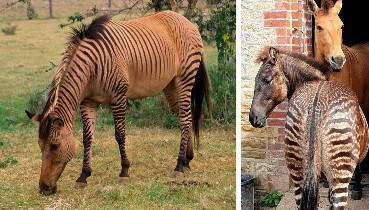 Striking Photos of Zorses Capture the Very Real Yet Rare Hybrid of a Zebra and Horse339 views
Striking Photos of Zorses Capture the Very Real Yet Rare Hybrid of a Zebra and Horse339 views-
Advertisements
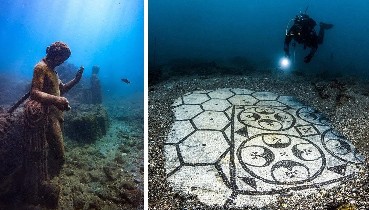 The Sunken Archaeological Park of Baia2064 views
The Sunken Archaeological Park of Baia2064 views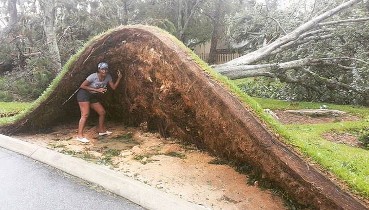 130 Times Nature Made People Go “Well, That Sucks”254 views
130 Times Nature Made People Go “Well, That Sucks”254 views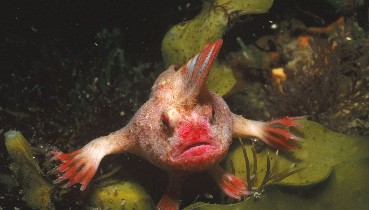 Extinct Animals - Smooth Handfish124 views
Extinct Animals - Smooth Handfish124 views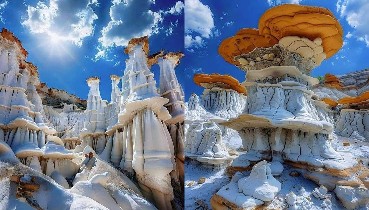 The Valley of Dreams is a natural wonderland located in northwestern New Mexico..192 views
The Valley of Dreams is a natural wonderland located in northwestern New Mexico..192 views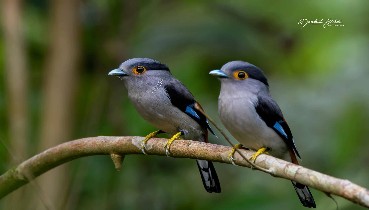 Silver-breasted Broadbill couple282 views
Silver-breasted Broadbill couple282 views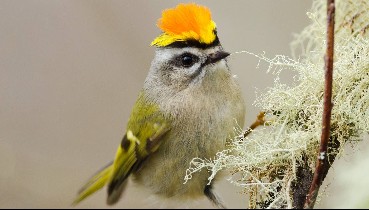 Golden-crowned Kinglet (Regulus satrapa)840 views
Golden-crowned Kinglet (Regulus satrapa)840 views
You may also like
 27 Times People Couldn’t Believe What They Saw At Walmart And Had To Take A Pic
27 Times People Couldn’t Believe What They Saw At Walmart And Had To Take A Pic 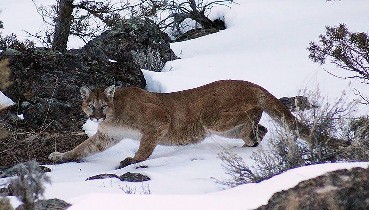 Be Careful, Deer Hunters! Rare Mountain Lion Sighting Confirmed In Southwest Arkansas
Be Careful, Deer Hunters! Rare Mountain Lion Sighting Confirmed In Southwest Arkansas 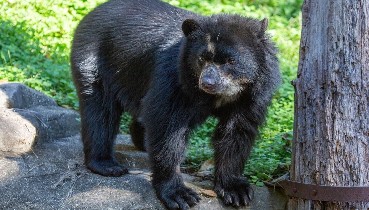 Rare Andean Bear Gives Birth to Two 'Active and Vocal' Cubs at the Smithsonian's National Zoo
Rare Andean Bear Gives Birth to Two 'Active and Vocal' Cubs at the Smithsonian's National Zoo  50 Rare Historical Photos That Will Impress You
50 Rare Historical Photos That Will Impress You